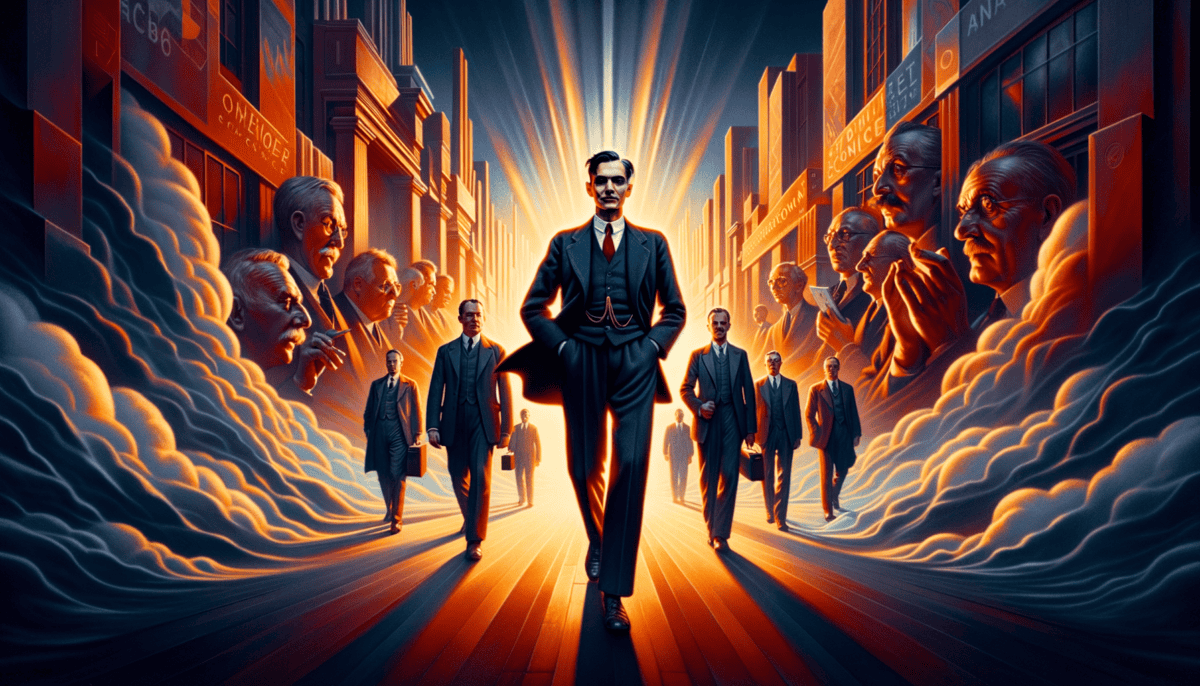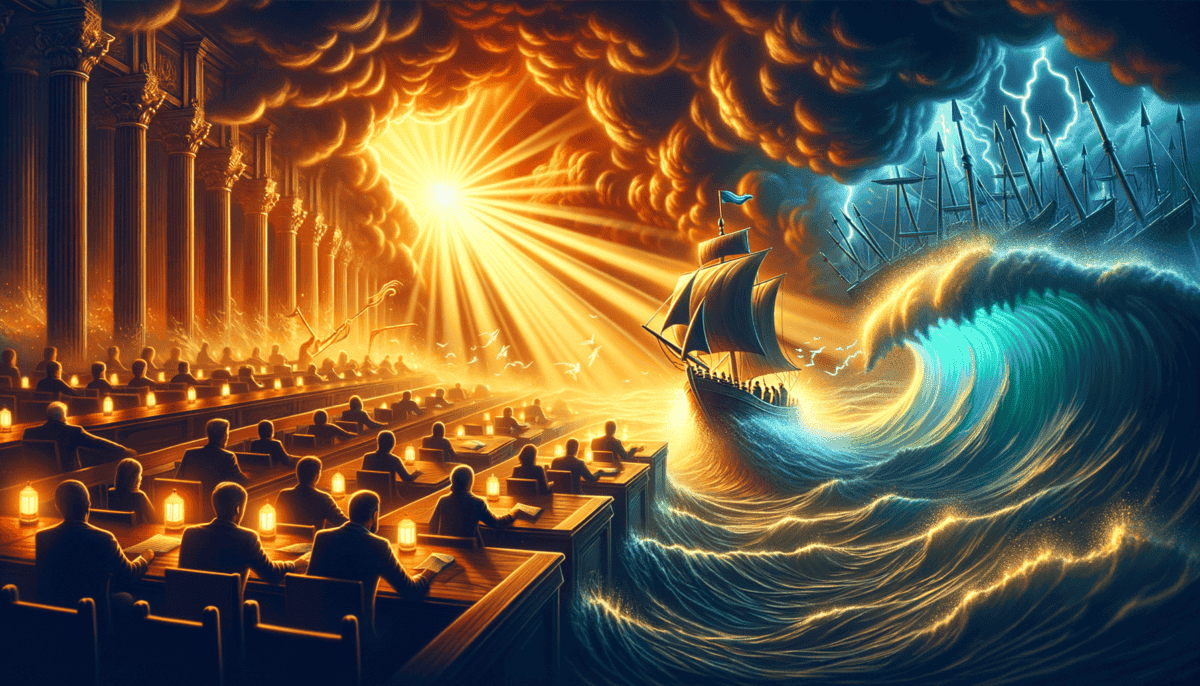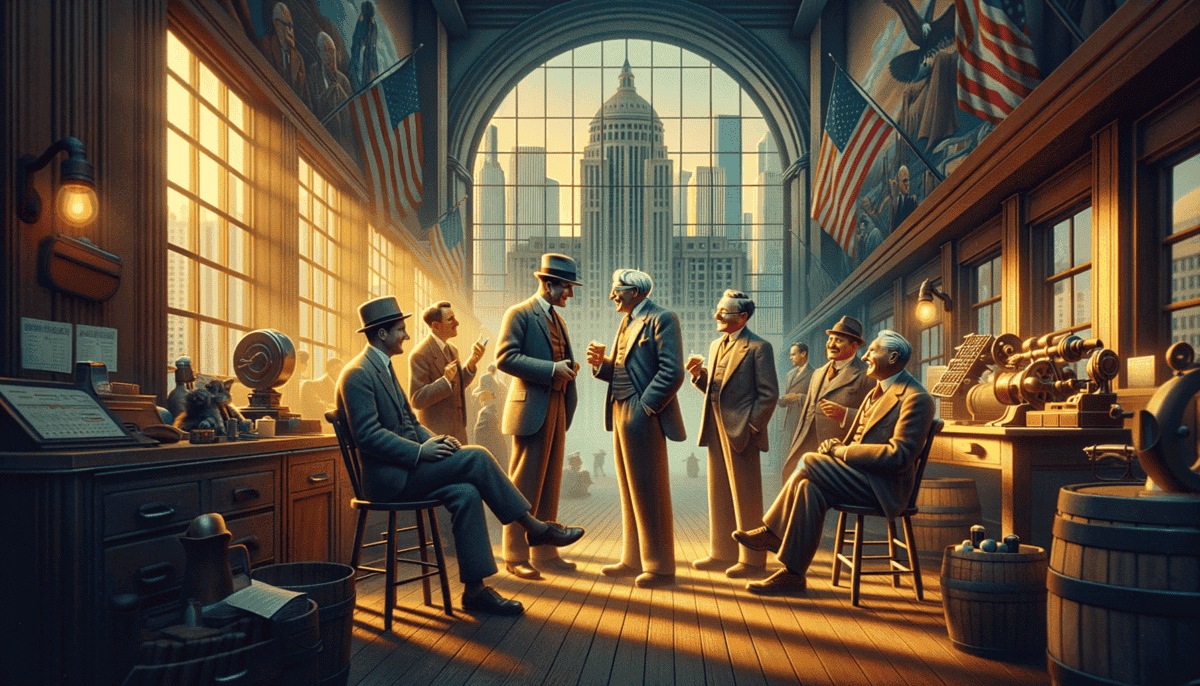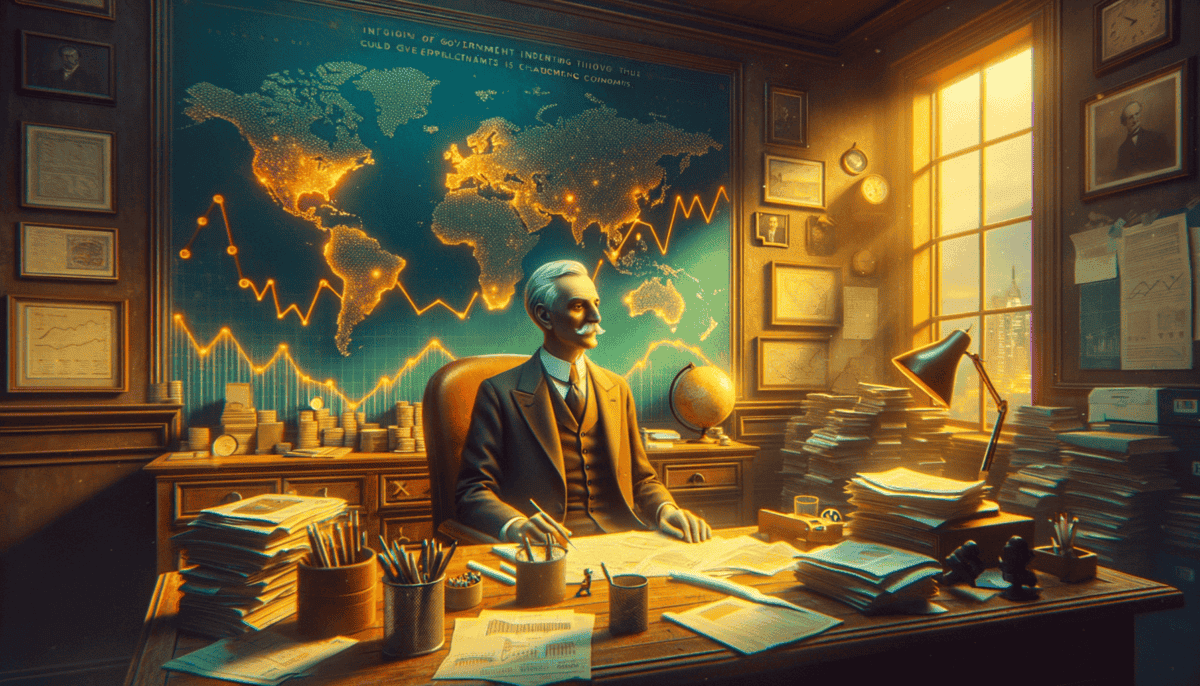Meet Young John at Cambridge
In a beautiful old school called Cambridge, there was a bright young boy named John Maynard Keynes. He loved numbers and solving puzzles. The year was 1902, and John was different from other students. While they played sports, he spent time thinking about money and how it moved around the world.
A Special Kind of Learning
"Why are some people rich while others are poor?" John asked his teacher one day.
His teacher smiled. "That's a very big question, John. What do you think?"
Little John looked out the window at the bustling streets of Cambridge. People walked by carrying bags of groceries, while fancy cars drove past horse-drawn carriages.
The Big Problem
As John grew older, he saw that the world had big money problems. It was like a giant piggy bank that wasn't working right. Some people had lots of coins, while others had empty pockets.
"Something isn't right," John told his friend Mary. "The old ways of thinking about money aren't helping everyone."
Mary nodded. "But what can anyone do about it?"
"I'm going to find out," John said with determination in his eyes. ✨
A New Way of Thinking
One rainy afternoon in the library, John made an important discovery. He realized that the way people thought about money was too simple. It was like they were using an old map to find their way in a new city.
“We need fresh ideas,” John wrote in his notebook. “The world is changing, and our thinking must change too.”
After World War I, many people were struggling. Soldiers came home to find no jobs. Factories closed. John knew he had to help fix these problems.
Making Friends and Finding Support
Not everyone liked John's new ideas. Some older professors shook their heads and said, "That's not how things work!"
But John didn't give up. He found other young thinkers who believed in his ideas. Together, they started writing about new ways to help the economy grow.
"We can make things better," John told his study group. "We just need to be brave enough to try something different."
His friends clapped and cheered. They knew John was onto something special.
| Old Ideas About Money | John’s New Ideas |
|---|---|
| Let problems fix themselves | Help fix problems right away |
| Government should do nothing | Government should help people |
A Promise to Help
As the sun set over Cambridge's tall towers, John stood at his window. He watched workers heading home after a long day. He thought about all the families trying to make ends meet.
"I promise to find a way to help," he whispered. "Everyone deserves a chance to live a good life."
Young John didn't know it yet, but his ideas would soon change the whole world. His journey was just beginning, and there were many adventures ahead.
The Peace Talk Challenge
The year was 1919. John walked into a big room in Paris where important leaders from many countries met. They were there to talk about what to do after the big war. The room was full of fancy chairs and serious faces.
Speaking Up for What’s Right
“We can’t make Germany pay so much money!” John said to the other leaders. “If we do, it will hurt everyone.”
The other leaders frowned. They wanted Germany to pay lots and lots of money because they were angry about the war.
Making New Friends
At the peace talks, John met people from all over the world. Some of them started to listen to his ideas about money.
“Tell us more,” said a friendly leader from France. “How can we help everyone get better after the war?”
“If we help each other, everyone wins,” John explained. “It’s like sharing toys in a playground – when everyone gets to play, everyone has more fun!”
Fighting for Better Ideas
Some of the older economists didn’t like John’s new ideas. They thought things should stay the same.
“But look!” John would say, pointing to his charts. “The old ways aren’t working anymore. We need to try something new!”
| Old Way | John’s New Way |
|---|---|
| Make countries pay big fines | Help countries grow together |
| Let problems fix themselves | Work together to fix problems |
Writing a Special Book
John was so worried about what might happen that he wrote a book about it. He called it “The Economic Consequences of the Peace.”
“If we’re too hard on Germany,” he wrote, “it will make everyone poor, not just Germany.”
Making Big Changes
Even though not everyone listened at first, John kept working hard. He talked to newspaper writers, gave speeches, and wrote more books.
“We need to help countries trade with each other,” he would say. “When countries work together, everyone gets richer!”
Some people started calling him “The Money Doctor” because he was so good at fixing money problems. ⚕️
Hope for the Future
As John left Paris, he looked back at the big building where the peace talks happened. He knew there was still a lot of work to do.
“I won’t give up,” he said to himself. “There must be a better way to help everyone have enough money to live happy lives.”
Little did John know, an even bigger challenge was coming. The world would soon need his ideas more than ever before. The sky was getting darker, and storm clouds were gathering. But John was ready to face whatever came next.
The Great Money Crash
The sky was dark on October 29, 1929. People were running around and shouting in the streets of New York. Something very bad was happening – the stock market had crashed!
A World in Trouble
John Keynes sat in his study in England, reading newspaper after newspaper. The news wasn’t good. Many people had lost their jobs and their money.
“This is exactly what I was worried about,” John said, shaking his head. “The old ways of thinking about money aren’t working anymore.”
John’s Big Idea
While others were scared, John was thinking hard. He had a new idea that was different from what other money experts said.
“The government needs to help!” John told his friends. “When people don’t have money to spend, the government should spend money to help them.”
| Old Think | John’s New Think |
|---|---|
| Wait for things to get better | Help make things better now |
| Let people solve their own problems | Government should help people |
Fighting for Change
Many people didn’t like John’s new ideas. They thought he was wrong.
“But look around!” John would say. “People need jobs! They need food! We can’t just wait and hope things get better!”
• Government should build roads and bridges
• Give people jobs and money
• Help farmers and workers
• Make sure everyone has enough food
Making Friends and Helpers
John started traveling around, telling people about his ideas. Some important people started to listen.
“This makes sense,” said a young helper from America. “When people have jobs, they can buy things. When they buy things, more people can have jobs!”
Writing a Very Important Book
In 1936, John wrote his most important book ever. He explained how money works in a whole new way.
“When times are bad,” he wrote, “the government should spend money to help people. When times are good, the government can save money.”
Hope Grows
Slowly but surely, more people started to believe in John’s ideas. They saw that helping people during hard times made sense.
“We’re all in this together,” John would say. “When we help each other, everyone wins!”
As the sun set on another busy day, John looked out his window. He could see people walking home from their new jobs. Children were playing in the streets again. Things were starting to look brighter.
But there was still more work to do. Across the ocean, a new president named Franklin Roosevelt was very interested in John’s ideas. Something big was about to happen in America…
Making America Work Again ️
The year was 1933, and a tall man named Franklin Roosevelt sat in the White House. He held a letter from John Keynes in his hands.
A Big Plan for America
“Mr. President,” the letter said, “we can help people by giving them jobs and building new things for America!”
Building a Better Country ️
Soon, amazing things started happening all across America:
• New roads connected cities and towns
• Beautiful parks gave people places to play
• Artists painted pictures in public buildings
• Farmers got help to grow more food
John’s Ideas Come to Life
“Look!” John said excitedly to his friends in England. “America is doing exactly what I said would work!”
“When the government helps people get jobs, they can buy food and clothes. Then stores stay open, and more people can work. It’s like a happy circle!”
Making New Friends
John traveled to America to meet President Roosevelt. They became good friends right away.
“Your ideas are helping millions of people,” Roosevelt told John. “We’re building things that will help America for many years to come.”
| Before New Deal | After New Deal |
|---|---|
| Many people without jobs | Millions of new jobs |
| Empty stores | Busy shops |
| Sad cities | Happy communities |
The World Takes Notice
Other countries watched as America started getting better. They wanted to try John’s ideas too!
Not Everyone Agrees
Some people still didn’t like John’s ideas. They thought the government was spending too much money.
“But look at all the good things we’re building!” John would say. “These roads and bridges will help people for many years. That’s worth spending money on!”
Letters from Happy People
John started getting letters from people in America:
“Dear Mr. Keynes, I got a job building a new park. Now I can feed my family again. Thank you!” – Tom from Ohio
A Change in the Air
As more people went back to work, stores got busier. Children could go to school again. Families had enough food to eat.
John smiled as he read the newspaper headlines: “America Coming Back to Life!”
But just as things were getting better, dark clouds were gathering over Europe. A big war was coming, and John would need to help in a whole new way…
Planning for Peace in Wartime
The year was 1939, and John Keynes was very worried. Dark clouds of war spread across Europe. But even in these scary times, John had a big dream – to help build a better world after the war ended.
Working Through War ✍️
“We must plan for peace even while fighting,” John told his friends at the British Treasury. He worked day and night to help Britain pay for the war without hurting people too much.
Many nights, John worked by candlelight in his office. His wife Lydia would bring him tea and sandwiches. “Don’t forget to rest, dear,” she’d say.
A Big Meeting in New Hampshire ️
In 1944, John traveled to a place called Bretton Woods in America. Leaders from 44 countries came together to talk about money and trade.
“If we want peace to last,” John said, “we need to help all countries work together and trade fairly.”
| Before Meeting | After Meeting |
|---|---|
| Countries fighting | Countries working together |
| Hard to trade | Easier to buy and sell |
| No help for poor countries | New banks to help everyone |
Building New Helper Banks
At the meeting, John helped create two very important banks:
• The International Money Fund – to help countries when they have money problems
A Tired Hero
All this hard work made John very tired. His heart wasn’t as strong as it used to be. But he kept working because he believed in his dream of a better world.
Letters from Around the World
John got letters from people everywhere:
“Dear Mr. Keynes, Thank you for helping our countries work together. Now my children can have a better future.” – Maria from Greece
Working Until the End
Even when he was very tired, John kept working. He traveled back and forth across the ocean many times to help America and Britain be friends and work together.
A Final Dream
“What do you see for the future?” a young helper asked John one day.
“I see a world where countries help each other,” John said with a smile. “Where people have good jobs and enough food to eat. Where we solve problems by talking, not fighting.” ️
The war was ending, but John knew his work wasn’t done. There were still many countries that needed help to rebuild…
A World Changed Forever
The sun rose on a spring morning in 1946. John Keynes sat in his favorite chair, looking out at his garden. He was tired but happy. His ideas were helping to build a better world.
Looking Back with Pride
John smiled as he remembered how far things had come. “When I was young,” he told his wife Lydia, “people said the government shouldn’t help during hard times. Now they know better.”
• Governments helping people find jobs
• Countries working together on money problems
• New banks helping poor countries grow
Good News from America
“Look at this!” John showed Lydia a letter from his friend in America. “They’re using my ideas to help soldiers coming home from war find jobs.”
“Your work is helping millions of people, John,” Lydia said proudly. “You’ve changed how the whole world thinks about money.”
Seeds of Hope Growing
All around the world, John’s ideas were working:
| Before | After |
|---|---|
| People without jobs | More people working |
| Countries fighting | Countries helping each other |
| No help in hard times | Government programs helping people |
A Special Visit
One day, a young student came to visit John. “Sir,” the student asked, “what makes you most proud?”
“That we’re learning to work together,” John answered. “That we now know we can fix big problems if we help each other.”
The Story Lives On
Even today, John’s ideas help people all over the world. When countries have money problems, they use his ideas to make things better.
A Better World
John passed away in April 1946, but his dreams lived on. His ideas helped build:
• A world where countries work together
• Ways to help people during hard times
• Better lives for millions of people
The Story Continues
Today, when governments help people find jobs or when countries work together to solve money problems, they’re using John’s ideas. His story shows that one person with good ideas can help make the whole world better.
And just like John taught us, when we work together and help each other, we can solve any problem – even the biggest ones in the whole world. His dream of a better future continues to inspire people everywhere.






